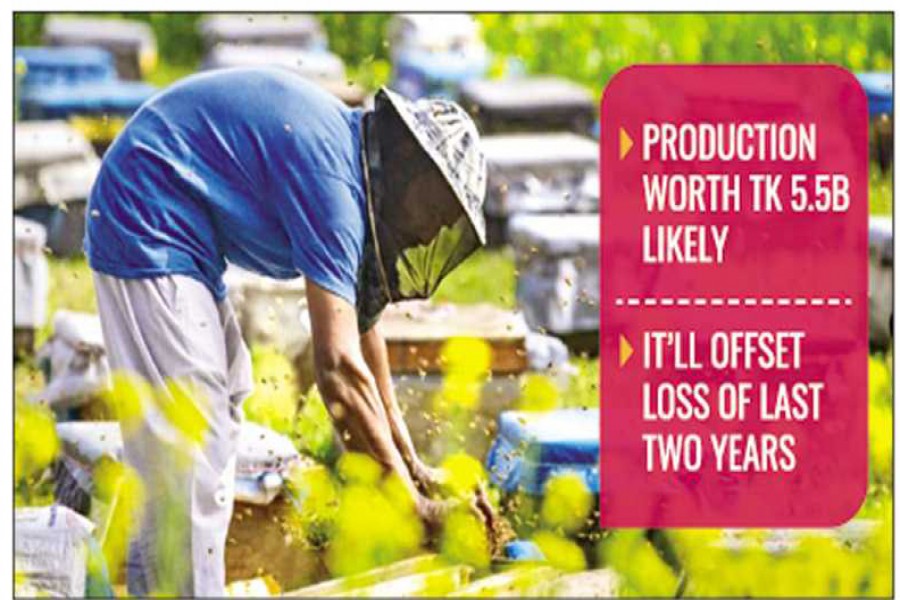Honey output is going to rise substantially this winter following persisting suitable weather as well as a notable surge in oilseed and spice- cultivation acreage, said insiders.
Honey cultivators and traders are expecting to offset their loss incurred in last two years due to odd weather.
Total honey production might surpass 11,500 tonnes and might worth Tk 5.5 billion this season, if good weather condition persists for next three to four months, they opined.
"Good growth of mustard seed flower helps us to get 20-25 per cent more honey this year than many other years," said Ratan Baroi, a honey collector at Islampur in Jamalpur.
"We are expecting that a honey hive would provide some 100 kgs of honey now, which was hardly 50 kgs last year."
"If flowering rate and daylight remain normal, we can easily extract 70-80 kgs from a single hive in 40 days."
He said water-logging amid untimely rain hampered their trade severely and production dropped by 30-40 per cent in the fiscal year 2021-22.
"I have 20 hives this year, from which I am expecting two tonnes of honey," he added.
Tarik Hasan Joy, another beekeeper at Bhuapur in Tangail, said both mustard seed fields in Dhaka and Mymensingh and litchi gardens in Dinajpur and Pabna regions witnessed low numbers of flowers last year.
Besides, random cold-wave squeezed sunlight, resulting in a fall in honey output.
"We could hardly get back our investments in last two years."
Mustard seed acreage has been expanded significantly in Mymensingh and Dhaka regions that will help to raise honey production, he noted.
Tangail, Manikganj, Gazipur, Dhaka, Jamalpur, Sirajganj, Bogra, Pabna, Natore, Madaripur, Faridpur, Thakurgaon, Dinajpur, Rajshahi, Magura, Jhenaidah, Meherpur, Jashore, Satkhira, Bagerhat, Khulna, Noakhali, Feni and Lakshmipur are key oilseed, spice, pulse and litchi growing districts in the country.
According to the Bangladesh Small and Cottage Industries Corporation (BSCIC), commercial beekeepers first collect honey from mustard and other oilseed fields in December-January period, then from black cumin, coriander and pulse fields in January-March period, and from litchi gardens in March-April period.
Besides, honey collectors of the Mouali community of the Sundarbans collect nectar from natural honeycombs of Khalisha or Keora flowers in February-April period.
Of the total honey production, fields of mustard and other oilseeds, spices, and pulses provide 4,500 tonnes, according to the BSCIC.
President of Bangladesh Beekeepers' Foundation Md Ebadullah Afzal said mustard fields are now the key source for honeybees.
"Bees also help to increase production of crops by raising pollination rate," he added.
Rezaul Karim, coordinator, honey value chain and market
development project under BASA Foundation, a PKSF-funded task, said they are expecting a good quantity of honey this year.
He informed the FE that they have trained 425 beekeepers in the hilly regions, who have started collecting honey.
"Though now in a low scale, commercial honey production in the hilly districts would increase vastly in the coming years. It could add a potential quantity to the national output."
"In the plain, we have trained 314 beekeepers, who are expecting a 20-25 per cent higher production this year thanks to a rise in oilseed acreage."
"Our trained beekeepers might get 1,500 tonnes of honey this season," he added.
The Department of Agricultural Extension (DAE) has targeted to grow more than 1.55 million tonnes of oilseeds on 0.882 million hectares of land, of which mustard comprises 0.67 million hectares.
The DAE said acreage of oilseeds increased by 12-15 per cent this year than that of last year amid higher demand from edible oil factories and animal feed mills.


